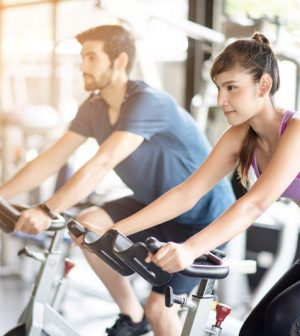- Navigating Your Midlife Crisis: Embracing New Possibilities
- City Raccoons Showing Signs of Domestication
- Mapping the Exposome: Science Broadens Focus to Environmental Disease Triggers
- One Week Less on Social Media Linked to Better Mental Health
- Your Brain Changes in Stages as You Age, Study Finds
- Some Suicide Victims Show No Typical Warning Signs, Study Finds
- ByHeart Formula Faces Lawsuits After Babies Sickened With Botulism
- Switch to Vegan Diet Could Cut Your Greenhouse Gas Emissions in Half
- Regular Bedtime Does Wonders for Blood Pressure
- Dining Alone Could Mean Worse Nutrition for Seniors
Women Need Better Guidance on Exercise & the Menstrual Cycle, Study Shows

“Cycle syncing” – the notion that women should adapt their diet and exercise patterns to their menstrual cycle – has become a trendy topic online.
Some experts argue that it can reduce a woman’s symptoms prior to and during her period.
But a new review has found little to no evidence supporting cycle syncing, or any other chic advice on eating, exercising or taking supplements during menstruation.
“Many women are following advice and planning exercises and practices based on some ostensible benefit of menstrual cycle phase-based exercise. We saw no evidence that such practice is science-based,” said senior researcher Stuart Phillips, a professor of kinesiology at McMaster University in Hamilton, Ontario, Canada.
In fact, researchers found sparse evidence exists on women and exercise at all, much less on the effect of their periods on their sports performance or physical fitness.
There’s no such thing as a “standard” menstrual cycle that lasts 28 days, with ovulation consistently occurring on day 14, researchers say. Hormone levels fluctuate dramatically and unpredictably.
“Hormone levels can vary substantially. Not just between two women, but within one woman from one cycle to the next,” co-lead researcher Mai Wageh, a doctoral candidate in McMaster’s department of kinesiology, said in a university news release.
Digging deeper, the researchers looked at specific physiological changes that might occur during the different phases of the menstrual cycle.
They found few to no standard changes when they looked at women’s use of fats versus carbohydrates, their potential for muscle growth or blood vessel function across the different cycle phases.
Instead, it seems it’s every woman for herself when it comes to eating and exercising during her period.
“Women can feel better or worse, and some are even incapacitated during various phases of their cycle,” Wageh said. “You need an individualized approach to training. Track your cycle and your symptoms in each phase and adjust your exercise plan accordingly. There is no one-size-fits-all approach.”
Researchers argue that more study is needed on women and the menstrual cycle, to provide data to better inform their choices throughout their cycle.
For example, researchers plan to examine whether symptoms associated with menstruation or PMS are cycle-related or due to other stress factors like lack of sleep, poor nutrition or life/work issues.
The new study was published recently in the Journal of Applied Physiology.
More information
The Office on Women’s Health has more about physical activity and the menstrual cycle.
SOURCES: McMaster University, news release, Dec. 5, 2023
Source: HealthDay
Copyright © 2025 HealthDay. All rights reserved.










